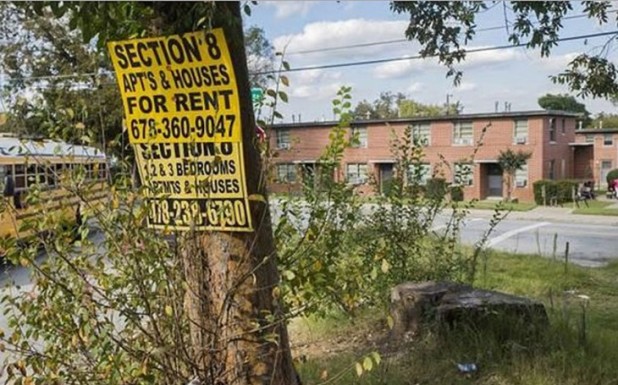The New Observer
May 10, 2016
Hillary Clinton’s rumored running mate, Housing Secretary Julian Castro, is preparing to relaunch a housing scheme which aims to force nonwhites into white suburbs across America.
The plan involves super-sizing vouchers to help “urban poor” afford higher rents in pricey areas, while assigning government real estate agents called “mobility counselors” to secure housing in the suburbs.
According to a report in the New York Post, titled “Obama’s last act is to force suburbs to be less white and less wealthy,” Castro plans to launch the Section 8 reboot this fall, even though a similar program tested a few years ago in Dallas has been blamed for shifting violent crime to affluent neighborhoods.
The program forms part of a “grand scheme to forcibly desegregate inner cities and integrate the outer suburbs,” the NY Post continued.
Castro last month threatened to sue suburban landlords for discrimination if they refuse Section 8 tenants with criminal records.
Last year, he also implemented a new regulation—“Affirmatively Furthering Fair Housing”—that pressures all suburban counties taking federal grant money to change local zoning laws to build more low-income housing.
Landlords of such properties are now required to accept Section 8 vouchers.
Castro is expected to finalize the new regulation, known as “Small-Area Fair Market Rents” (SAFMR), this October, in the last days of the Obama presidency.
It will set voucher rent limits by zip code rather than metro area, the current formula, which makes payments relatively small.
For example, the fair market rent for a one-bedroom in New York City is about $1,250, which wouldn’t cover rentals in the more affluent areas of Westchester County, such as Mamaroneck, “where Castro and his social engineers seek to aggressively resettle Section 8 tenants,” the NY Post said.
In expensive zip codes, Castro’s plan—which requires no congressional approval—would more than double the standard subsidy, while also covering utilities.
At the same time, he intends to reduce subsidies for those who choose to stay in housing in poor urban areas, such as Brooklyn. So Section 8 tenants won’t just be pulled to the suburbs, they’ll be pushed there.
“We want to use our housing-choice vouchers to ensure that we don’t have a concentration of poverty and the aggregation of racial minorities in one part of town, the poor part of town,” the HUD chief said, adding that he’s trying to undo the “result of discriminatory policies and practices in the past, and sometimes even now.”
A draft of the new HUD rule anticipates more than 350,000 Section 8 voucher holders will initially be resettled under the SAFMR program. Under Obama, the total number of voucher households has grown to more than 2.2 million.
The document argues that larger vouchers will allow poor urban families to “move into areas that potentially have better access to jobs, transportation, services, and educational opportunities.”
The theory is that offering them more money to move to more expensive neighborhoods will “improve their situation.”
But, as the NY Post pointed out, HUD’s own studies show the theory doesn’t match reality.
President Bill Clinton started a similar program in 1994 called “Moving to Opportunity Initiative,” which moved thousands of blacks from government projects to higher-quality homes in safer and less racially segregated neighborhoods in several counties across the country.
The 15-year experiment failed dramatically, the NY Post continued:
A 2011 study sponsored by HUD found that adults using more generous Section 8 vouchers did not get better jobs or get off welfare.
In fact, more went on food stamps. And their children did not do better in their new schools.
Worse, crime simply followed them to their safer neighborhoods, ruining the quality of life for existing residents.
“Males … were arrested more often than those in the control group, primarily for property crimes,” the study found.
Dubuque, Iowa, for example, received an influx of voucher holders from projects in Chicago—and it’s had a problem with crime ever since. A recent study linked Dubuque’s crime wave directly to Section 8 housing.
HUD then decided, the NY Post said, that the solution to the “problem” was not to halt the program, but that it was not aggressive enough. They concluded they could get the desired results if they placed urban poor in even more affluent areas.
HUD recently tested this new theory in Dallas with disastrous results.
Starting in 2012, the agency sweetened Section 8 voucher payments, and pointed inner-city recipients to the far-flung counties surrounding Dallas.
As government-subsidized rentals spread in all areas of the Metroplex (163 zip codes vs. 129 zip codes), so did crime.
Now Dallas has one of the highest murder rates in the nation, and recently had to call in state troopers to help police control it.
For the first time, violent crime has shifted to the communities north of the city. Three suburbs that have seen the most Section 8 transfers—Frisco, Plano, and McKinney—have suffered unprecedented spikes in rapes, assaults, and break-ins, including home invasions.
Castro wants now to roll this program out nationwide. Soon he will give Section 8 recipients money to afford rent wherever they choose—and if they don’t want to move, he’ll make them an offer they can’t refuse, the NY Post said.
Ironically, Hillary’s own hometown of Chappaqua is fighting Section 8 housing because of links to drugs and crime and other problems.
 Daily Stormer The Most Censored Publication in History
Daily Stormer The Most Censored Publication in History



